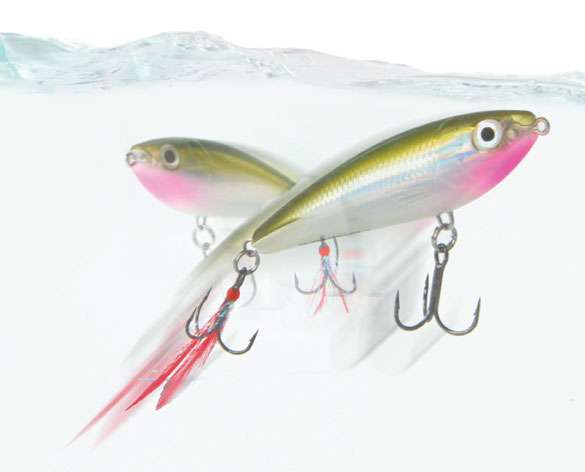
The hypnotic side-to-side gait of a topwater lure, such as a Zara Spook or a Lucky Craft Sammy, can produce vicious and predictable strikes, but when the fish fail to connect it can leave an angler scratching his head.
Conditions may be perfect for topwater fishing, but sometimes the bass just won’t fully commit. Instead, they’ll swim up, boil on a lure and head back down unscathed. That’s the situation that confronted Rapala’s Mark Fisher last fall while filming a TV show in Minnesota, and it led him to pick up a bait he’d had a hand in designing, but had not yet really figured out.
“We were side imaging schools of bait on a ledge,” he recalls. “The smallmouth were running deeper breaks in 18 to 20 feet of water. We’d been catching them on topwaters, but on film day it just wasn’t happening. I picked up a Rapala SubWalk, which we’d released six or seven years ago. I threw right back to where I’d had the blowup, made two pulls and got throttled.”
Meanwhile, nearly a thousand miles away in Alabama, guide Jimmy Mason encountered a similar problem. “In the late summer and fall on the Tennessee River, the smallmouth start schooling on points and on gravel flats, but some days they just won’t break the surface,” he says. In that situation, he employs a Bomber Badonk-A-Donk, a saltwater lure designed for species like snook and redfish. “It has a really loud rattle,” the former Elite Series pro says. “Not only does it attract smallmouth from a longer distance than a soft jerkbait, but it works in dirtier water, too.”
Farther west, 2012 Bassmaster Classic qualifier Andrew Upshaw has found a similar lure, the Strike Pro Baby Buster, to be deadly on largemouth — and, in particular, kicker fish — in vegetation. Slow sinking walk-the-dog lures are a largely untapped genre, so when fish explode on your topwaters and don’t connect, it may be time to take your walk-the-dog cadence slightly under the surface.
When And Where To Drown The Dog
“The toughest challenge in bass fishing is still suspended bass,” Fisher says. The times when fish suspend include early prespawn, in the immediate postspawn, and then again in the fall. While they’ll often chase a topwater during those periods, that bite can turn off like a light switch.
“Up North, I like the SubWalk in June, July and August,” said two-time Classic qualifier Terry Baksay. “A lot of times in the postspawn they’re interested but don’t want to eat something like a popper. They’ll blow up and miss it, but he thinks he hurt it. The SubWalk is the ultimate comeback bait. It’s so subtle, he thinks it’s in the death throes so he’ll come back and get it. It’s perfect in places with a lot of grass like the Potomac. It sinks so slowly you can almost walk it in place.”
Upshaw agrees that the subsurface walkers are deadly around submerged vegetation. On his home lakes of Sam Rayburn and Toledo Bend, he’ll pull out the Buster where others might throw a lipless crankbait, or even a suspending jerkbait before the grass gets up. “It has a bigger profile, which makes it more of a target,” he said. “It draws bigger strikes.”
The bite re-emerges in the fall. In largemouth country, that’s because the shad get bigger and the bass get more aggressive, Upshaw says. Where smallmouth are involved, it preys upon their wolfpack mentality.
As for ideal conditions, Upshaw says inclement weather is best. “When it’s a bit windy, it makes it better,” he explains. “But cloudy days are better than anything.” Indeed, when wind makes it less likely bass will be able to get a good shot at a topwater lure, the subsurface walkers shine, delivering the same alluring action while maintaining a predictable rhythm.
Establishing The Proper Retrieve
As with a topwater bite, the proper way to pull the subsurface walker can change from day to day, or even from hour to hour, but the pros believe that there are general rules that should guide the search.
“In the prespawn, they’re starting to look up a bit,” Upshaw says. “I’ll fish the Buster a lot slower, giving it real methodical jerks, looking for a bigger bite. But in the fall, I’ll use a lot bigger line and fish it a lot faster, trying to get them to react. In the early spring, my typical starting point is three pulls, then stop, then one pop. In the fall, it’ll be faster, with lots of popping and jerking.”
Mason said that his typical starting point with the Badonk-A-Donk is “a cross between walking the dog and the way you’d fish a Fluke, with a twitch-twitch-pause cadence. I’ll go a little faster than that, giving it three or four twitches, then pausing it.”
Fisher added that his lure will walk-the-dog just like their topwater version, the Skitter Walk, but it can also be made to glide so subtly that with the rod tip down even a beginner can nail the cadence with ease. “You just pull it straight,” he said. “You don’t have to lead it.” He added that a loop knot will also make it easier to get the retrieve down pat.
“Your cadence is a discernable part of your success,” Fisher adds. “Sometimes they want it real hard, other times they’ll want it in a lollygagging sweep. Usually, the shallower they are, the more aggressively I’ll fish it.”
Tackle To Walk With
Long casts are usually critical with this technique, to allow the bait to establish its mesmerizing walking pattern. For that reason, the pros typically use long rods. Mason likes a Dobyns medium-fast model 733 (7 foot, 3 inches, 3-power) to maximize distance, or a more forgiving 705CB fiberglass rod when long casts aren’t quite as important. Upshaw prefers anything from a standard medium-heavy worm rod all the way up to a flipping stick, depending on the size of fish around and the thickness of the cover. Both anglers use a Lew’s Tournament Pro 6.4:1 gear ratio baitcasting reel in the spring, although Upshaw will speed up to a 7.1:1 model in the fall, when a more aggressive presentation is warranted.
Mason uses 20-pound Vicious braided line when he’s getting bites at the end of long casts, but when more action is required out of the bait, braid can be a detriment because it limits the “glide” at the end of the walking motion. Fluorocarbon, Upshaw explains, allows the lure to “sink a little better and has no stretch, so you can feel it popping, but you won’t rip it out of his mouth.” He likes 15-pound Izorline. Baksay and Fisher both prefer monofilament.
Concern over maximizing the side-to-side range also prevents Mason from adding a feathered rear treble, a modification he employs with most topwaters. “It creates drag,” he explains. “You don’t get as much dart.”
In a lure where the action is the main attractor, color may not be critical, but it’s still a part of fine-tuning the presentation. Fisher sticks with patterns that imitate a wide range of baitfish, like silver with an olive back and gold with an olive back. The others tend to tailor their choices to the amount of sunlight penetration on a given day.
“My two main choices are bone and pearl,” Mason says. “Bone is by far the best color when there’s heavy overcast or when the water is a little stained because it has more of a silhouette. Pearl tends to produce a little better when it’s clear.”
Upshaw expands out a little bit from there. The Strike Pro pattern known as “ate-o-ate” (black back, bronze sides and an orange belly) is his favorite in the prespawn, although he’ll switch to the translucent grey ghost when it’s very sunny. In the fall, he dotes on chrome with a black back to imitate fleeing shad, especially if it’s cloudy. “It gives off a lot of flash under all conditions,” he explains. Like Mason, he also utilizes a pearl version when shad are prevalent. Finally, he uses a color Strike Pro calls “pink-a-licious.” “It just stands out so much,” he says, and in addition to being deadly on hungry largemouth, it should be a standout for smallmouth who tend to key in on garish colors.
When the topwater bite becomes less-than-perfect, rather than make a wholesale switch to a spinnerbait or swimbait, sometimes it can pay to take the same walking action and just place it subsurface. As Mason says, “The fish today see everything. They get absolutely hammered, so you have to adapt. Sometimes that means a one-knocker rattlebait versus a standard rattlebait. Or maybe it means picking up an old-school bait.” In this case, it means borrowing from the saltwater and toothy critter arsenals and ratcheting your topwaters down a notch.
The Bigger The Treat, The Badder The Bite
In addition to the SubWalk, Rapala makes the lipless Glidin’ Rap, which as the name suggests has more of a gliding action than a hard snapping, side-to-side gait, with predictable swings elicited by both twitches or gentle pulls of the rod.
Available in both 4 3/4-inch and 6-inch sizes, with beefy 2/0 trebles, it’s become popular among the Northern pike and muskellunge chasers, but along the way, the toothy critter aficionados have landed lots of big bass on it.
“We came out with it a year too late,” Fisher laments. “It would have been deadly [in the Elite Series events] at Falcon and Amistad around flooded brush.”
While the SubWalk is typically thrown in the 2 3/4- and 3 1/2-inch sizes, it is available in a 6-inch, 2-ounce jumbo model.
Originally published November 2012






